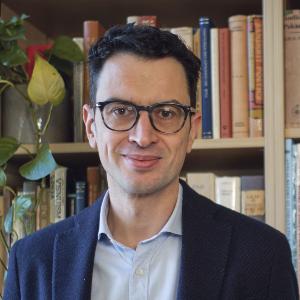Searching the Indian Buddhist heritage
8 Dec 2023
Professor Vincent Tournier, the new holder of the Chair of Classical Indology at LMU, is exploring the origins and early history of Buddhism.
8 Dec 2023
Professor Vincent Tournier, the new holder of the Chair of Classical Indology at LMU, is exploring the origins and early history of Buddhism.

Professor Vincent Tournier | © LC Productions
Indologist Vincent Tournier’s travels take him to the British Museum in London or the Metropolitan Museum in New York, to monuments in Southern India, and to manuscripts collections in Nepal and Japan. Why? Because the professor, who last year took the Chair of Classical Indology at LMU, is conducting research into the history of Buddhism. Traces of this religion can be found not only in texts in a wide variety of languages, but also in works of art and monuments around the globe.
Tournier studied history, anthropology, and the sciences of antiquity at the University of Strasbourg, where he also learned Sanskrit and developed an interest in the history of Buddhism.
For a dissertation on the scriptural heritage of an influential Buddhist school, composed in a heterogenous language combining Middle Indic and Sanskrit, he enrolled at the renowned École Pratique des Hautes Études in Paris. As a postdoctoral researcher investigating issues of hierarchy and social justice in Buddhist societies, he then moved to Leiden University in the Netherlands, before being granted, in 2013, his first permanent appointment at SOAS, University of London. After that he became, in 2018, an Associate Professor at the École française d’Extrême-Orient (EFEO) in Paris, and in 2022, he was appointed Professor of Classical Indology at LMU’s Department for Asian Studies.
Tournier studies the rise of Buddhism, which originated in India around the 4th century before the Common Era. His research is concentrated on the period up to the 9th century CE. “Historically speaking, Buddhism is primarily Indian religion, which spread most of Asia,” the historian says. The reason why it is often not associated with India is that its significance on the subcontinent radically declined between the 13th and 19th centuries, he adds, even though it remained a major or even dominant force in neighboring countries such as Nepal, Sri Lanka, and continental Southeast Asia. “The same was true of Afghanistan, Iran and Indonesia, for instance, which we hardly associate with Buddhism today.” Tournier is especially interested in monastic lineages and patronage. “Compared to medieval Christian orders, these monasteries were highly structured,” the professor notes. “We examine the gifts they received from wealthy supporters such as kings, their relationships with political rulers and how they competed with other religious traditions, such as the so-called ‘Hindu’ cults of Shiva and Vishnu, for support.”
Historically speaking, Buddhism is primarily Indian religion, which spread most of AsiaProfessor Vincent Torunier
The french researcher also studies the languages and literatures of the Indian subcontinent. “Every monastic order had a different version of the canon compiling the Buddha’s teachings,” Tournier explains. “I am particularly interested in those orders that no longer exist today, which tend to be under-represented in academic discourses about Buddhism.” And to gain a deeper understanding of their history, he insists that is fundamental to know the original languages. Alongside Indic languages such as Sanskrit and Pali, these also include Tibetan and Chinese. “Many Buddhist sources have never been studied or worked on, let alone translated,” Tournier concedes, adding that many texts are not extant anymore in their Indic original, and that we can only access them through Chinese or Tibetan translations. The professor is keen to familiarize his students, too, with such languages, “which allow first-hand access to this exceptionally complex world of thought, and also to the beauty of Indian and Buddhist literature”.
Tournier had already visited Munich and LMU as a doctoral student and later as a visiting researcher. The Institute for Indology and Tibetology at LMU, which Tournier now leads, is acknowledged worldwide as a center for the study of Buddhism, and it is very well connected internationally. Locally, its members cooperate with such organizations as the Bavarian Academy of Sciences and Humanities (BAdW), where two long-term projects – on a Tibetan dictionary and on the early Buddhist manuscripts from the Gandhāra region of Pakistan – are currently undertaken.
Tournier’s research further led to his involvement within the European project “The Domestication of ‘Hindu’ Asceticism and the Religious Making of South and Southeast Asia” (DHARMA). At its core, this project analyzes inscriptions, texts engraved in such materials as copper and stone. Tournier tracks Indian Buddhist inscriptions down at archeological sites and in museums, documenting them and interpreting them from a new scientific perspective. These records are of the highest significance to trace the spread, the institutionalization, and the self-representation of Buddhist communities in Ancient India and beyond.